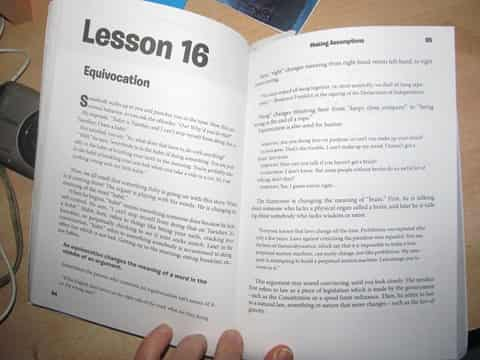Disclosure: I received this complimentary product through the Homeschool Review Crew.
A few months ago, my mom wrote a letter to one of my children, and mentioned looking something up in The Fallacy Detective. That piqued my interest in the book, and when, soon after that, I was offered a chance to review the book, I jumped at the chance! Of course, the fact that the authors, Nathaniel Bluedorn and Hans Bluedorn, were willing to send us a physical copy made the book even more attractive. Not very many physical books are sent here for review.
We’ve been reading through The Fallacy Detective as a family. Several evenings a week, I read a lesson aloud at the dinner table, and then we discuss the questions at the end of the lesson and try to figure out the answers. It has been a lot of fun! We are really enjoying this book. We’re learning to recognize fallacies, too. Quite often, someone will call out, “That’s a red herring!” or “You’re using a straw man argument!” Today, one of our boys used equivocation, and when we were discussing a possible scenario, I said, “That’s special pleading!”
There are five sections in this book. The first, The Inquiring Mind, includes three chapters about the importance of exercising your mind and learning to listen to others. The second section, Avoiding the Question, includes a lesson or two about several different fallacies. We had a lot of fun with the chapters about Red Herrings, Special Pleading, and the Straw Man Fallacy. Some of the children like to say the words Ad Hominem and Tu Quoque—and trying to remember what they mean!
We’re working through the third section of the book right now, Making Assumptions. The first lesson in this section is a story, and then there are questions about whether statement were true according to the story, or not. It was fun to see what assumptions we made that weren’t actually in the story! We have also learned to recognize circular reasoning, equivocation and loaded questions in this section. The Slippery Slope was quite interesting, and I’m looking forward to the Part-to-Whole and Whole-to-Part lessons next.
Coming up, we have sections titled Statistical Fallacies and Propaganda. I’ve already been pointing out examples of these to the children when I see them in the media, so it will be interesting to read the lessons about them and learn what the Bluedorns have to say.
Each lesson describes a particular type of fallacy in an interesting way, using conversations or stories to get the point across. Most lessons have a comic strip (often Calvin and Hobbes or Snoopy), or a cartoon. My younger set love comics, so they like to look at the book just for those! In fact, the day it arrived in the mail, the book got soaked because someone was reading it while holding a cup of water (I was glad I had taken a photo for this post already!). After the fallacy is thoroughly described and illustrated, there are a number of conversations or short stories given, and the assignment is to identify the fallacy included, if there is one. Some of these questions poke fun at the authors. That always gets a laugh here! Some of the members of our family are getting very good at identifying the fallacies! We’re all glad there is an answer key at the end of the book.
The The Fallacy Detective is a great book from which to learn logical thinking and recognize bad reasoning. It’s also a lot of fun! We laugh a lot while we’re working on these lessons. Everyone in the family is enjoying it; if I forget to read a lesson, I’m usually reminded, and not always by the same person. Elijah and Esther are probably the most interested, but even Mr. Sweetie and Mr. Imagination enjoy the lessons. Every family should get this book and have fun learning to recognize faulty reasoning together, although it is quite possible to go through it alone and learn a lot, too. It’s just not as fun! Be sure to click the image below to read other people’s reviews of this fascinating book!






Leave a Comment